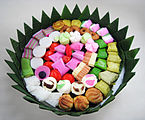 White sugar-powdered putri salju | |
| Type | Kue kering (traditional cookie) |
|---|---|
| Course | Snack, dessert |
| Place of origin | Indonesia |
| Region or state | Southeast Asia |
| Associated cuisine | Indonesia |
| Serving temperature | Room temperature |
| Main ingredients | Flour, butter, egg yolks, powdered sugar |
| 62 (per 12.0 gr) [1] | |
Putri salju (Indonesian : kue putri salju) is an Indonesian kue kering (dried kue or cookie) shaped like crescents and covered with powdered sugar. Putri salju is Indonesian for "snow princess", referring to the powdered sugar coating that resembles snow, [2] and the sugar coating sometimes gives cooling sensation while eaten.
Contents
Putri salju is a typical delicacy for festive occasions and major holidays, such as Lebaran (Eid ul-Fitr), Natal (Christmas) and Imlek (Chinese New Year). [3] Putri salju cookies are usually sold in air-tight plastic or glass jars in traditional markets, bakeries, pastry shops and supermarkets.

